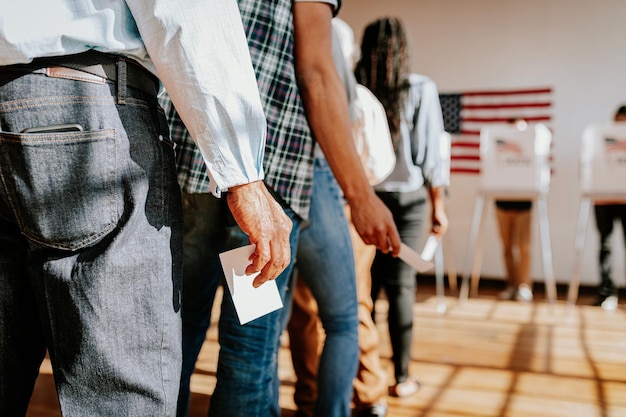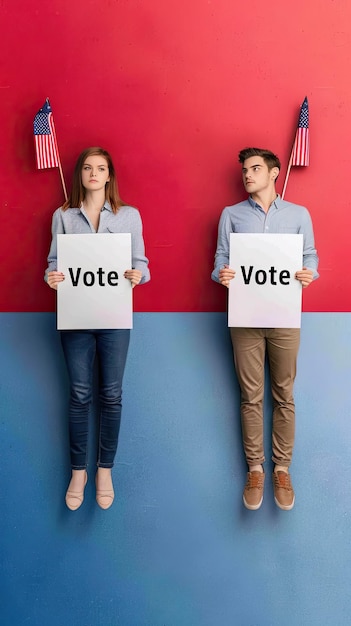Voting Rights Act 2025: Will It Affect US Voter Turnout?

The Proposed Voting Rights Act of 2025 aims to modernize and protect voting access across the United States, potentially increasing voter turnout by addressing historical barriers and promoting fair election practices, although its ultimate impact will depend on its specific provisions and how effectively they are implemented.
Understanding the potential impact of the Proposed Voting Rights Act of 2025 on voter turnout is crucial for anyone interested in the future of American democracy, and the integrity of elections.
How Will the Proposed Voting Rights Act of 2025 Impact Voter Turnout?
The potential impact of the Proposed Voting Rights Act of 2025 on voter turnout is a subject of intense debate and analysis. The Act seeks to address various challenges related to voting access and equality, but its success will depend on the specific provisions enacted.

The Voting Rights Act of 1965 was landmark legislation that aimed to overcome legal barriers at the state and local levels that prevented African Americans from exercising their right to vote as guaranteed by the 15th Amendment to the U.S. Constitution. However, in recent years, the Act has been weakened by Supreme Court decisions, leading to concerns about voter suppression and reduced access to the polls. Let’s delve into the different components of the bill and their impact.
Key Provisions of the Proposed Act
The Proposed Voting Rights Act of 2025 includes several key provisions designed to enhance voter access and protect against discrimination. These provisions are intended to modernize voting systems, ensure equal access to the polls, and combat voter suppression tactics.
- Modernizing Voter Registration: The act may include provisions for automatic voter registration, allowing eligible citizens to be automatically registered when interacting with government agencies.
- Expanding Early Voting: The expansion of early voting periods can provide more opportunities for people to vote at their convenience, which is particularly beneficial for those with inflexible work schedules or limited transportation.
- Protecting Against Voter Purges: Strict regulations on voter purges can prevent eligible voters from being wrongly removed from the voter rolls, ensuring that they can cast their ballots without unnecessary obstacles.
These provisions, if effectively implemented, are expected to contribute positively to voter turnout by making it easier for eligible citizens to register and vote.
In conclusion, the Proposed Voting Rights Act of 2025 aims to remove barriers to voting and promote greater participation in elections through various modernization and protection measures.
Historical Context and the Need for Reform
Understanding the historical context of voting rights in the United States is essential to appreciating the significance of the Proposed Voting Rights Act of 2025. The struggle for voting rights has been a long and arduous process, marked by periods of progress and setbacks.
Historically, various groups have faced significant obstacles to voting, including African Americans, Native Americans, women, and people with disabilities. Discriminatory practices such as poll taxes, literacy tests, and restrictive registration requirements were used to disenfranchise these groups.

The Voting Rights Act of 1965 was a watershed moment in the fight for voting rights, but recent Supreme Court decisions have weakened its protections. Specifically, the 2013 Shelby County v. Holder decision removed the preclearance requirement for certain states with a history of voting discrimination, leading to concerns about new restrictive voting laws.
The Impact of Shelby County v. Holder
The Shelby County v. Holder decision has had a significant impact on voting rights in the United States. Without the preclearance requirement, states with a history of discrimination have been able to enact new voting laws without federal oversight.
- Increased Voter ID Laws: Some states have implemented stricter voter ID laws, requiring voters to present specific forms of identification at the polls. This can disproportionately affect low-income individuals and minority groups who may not have the required identification.
- Reduced Early Voting: Other states have reduced or eliminated early voting periods, making it more difficult for people to vote at their convenience.
- Purging of Voter Rolls: There have been cases of aggressive voter roll purges, where eligible voters have been wrongly removed from the voter rolls, leading to disenfranchisement.
The Proposed Voting Rights Act of 2025 seeks to address these issues by restoring and strengthening federal protections for voting rights.
In conclusion, the historical context and recent Supreme Court decisions highlight the need for reform to ensure that all eligible citizens have equal access to the ballot box.
Potential Benefits of the Proposed Act
The Proposed Voting Rights Act of 2025 offers several potential benefits for voter turnout and democratic participation. By addressing barriers to voting and promoting fair election practices, the Act could lead to increased engagement in the electoral process.
One of the primary benefits of the Act is its potential to increase voter turnout among historically disenfranchised groups. By modernizing voter registration and expanding early voting, the Act can make it easier for more people to participate in elections.
The Act also aims to protect against voter suppression tactics, such as discriminatory voter ID laws and aggressive voter roll purges. By ensuring that all eligible citizens can vote without unnecessary obstacles, the Act could strengthen the integrity of elections and promote public confidence in the democratic process.
Specific Benefits for Different Groups
The Proposed Voting Rights Act of 2025 could have specific benefits for different groups within the electorate. These benefits could include addressing unique challenges faced by particular communities and ensuring that their voices are heard in elections.
- Minority Communities: The Act can protect against discriminatory voting practices that disproportionately affect minority communities, ensuring that they have equal access to the polls.
- Young Voters: Modernizing voter registration can make it easier for young people to register and vote, promoting greater engagement among this demographic.
- People with Disabilities: The Act can ensure that polling places are accessible to people with disabilities, allowing them to participate fully in the electoral process.
By tailoring its provisions to address the needs of different groups, the Act has the potential to promote a more inclusive and representative democracy.
In conclusion, the Proposed Voting Rights Act of 2025 offers significant potential benefits for voter turnout, democratic participation, and the inclusion of diverse communities in the electoral process.
Potential Challenges and Obstacles
Despite its potential benefits, the Proposed Voting Rights Act of 2025 may face several challenges and obstacles in its implementation. These challenges could include political opposition, legal challenges, and logistical difficulties.
One of the primary challenges facing the Act is political opposition from those who believe it represents an overreach of federal power into state election matters. This opposition could lead to legislative gridlock and efforts to weaken or block the Act’s provisions.
The Act may also face legal challenges from those who argue that it violates constitutional principles or infringes on state sovereignty. These challenges could delay or prevent the Act from being implemented.
Logistical and Administrative Challenges
In addition to political and legal challenges, the Proposed Voting Rights Act of 2025 may face logistical and administrative difficulties in its implementation. These difficulties could include challenges related to voter education, polling place accessibility, and election administration.
- Voter Education: Ensuring that all eligible citizens are aware of their rights and responsibilities under the Act may require significant investment in voter education and outreach programs.
- Polling Place Accessibility: Making polling places accessible to people with disabilities and others with special needs may require physical modifications and accommodations.
- Election Administration: Implementing modern voting systems and ensuring the integrity of the electoral process may require careful planning and coordination among election officials.
Overcoming these challenges will require a concerted effort from government agencies, advocacy groups, and community organizations.
In conclusion, the Proposed Voting Rights Act of 2025 faces significant challenges and obstacles in its implementation, but these can be overcome with a concerted effort from all stakeholders.
The Role of Technology and Modernization
Technology and modernization play a crucial role in the Proposed Voting Rights Act of 2025, offering opportunities to enhance voter access, improve election administration, and combat voter suppression tactics. Embracing technological innovations can help create a more inclusive and efficient electoral process.
One of the key ways that technology can contribute to the Act’s goals is through modernizing voter registration systems. Online voter registration and automatic voter registration can make it easier for eligible citizens to register and update their information, reducing barriers to participation.
Technology can also be used to improve the accessibility of polling places. Electronic voting machines with audio and visual aids can assist voters with disabilities, while online resources can provide information about polling place locations and hours.
Cybersecurity and Election Integrity
While technology offers many benefits for election administration, it also poses potential risks, particularly in the area of cybersecurity and election integrity. Protecting against cyberattacks and ensuring the accuracy and reliability of voting systems is essential to maintaining public confidence in the democratic process.
- Secure Voting Machines: Using voting machines with robust security features and conducting regular audits can help prevent tampering and ensure accurate vote counts.
- Cybersecurity Training: Providing cybersecurity training to election officials and staff can help them identify and respond to potential cyber threats.
- Public Awareness Campaigns: Conducting public awareness campaigns about the importance of cybersecurity can help voters understand the risks and take steps to protect their own information.
By addressing these challenges and embracing technological innovations, the Proposed Voting Rights Act of 2025 can create a more secure and accessible electoral process.
In conclusion, technology and modernization play a critical role in the Proposed Voting Rights Act of 2025, offering opportunities to enhance voter access, improve election administration, and combat voter suppression tactics.
Public Opinion and Advocacy Efforts
Public opinion and advocacy efforts play a significant role in shaping the debate around the Proposed Voting Rights Act of 2025. Public support for the Act can help build momentum and overcome political opposition, while advocacy efforts can raise awareness and mobilize voters.
Public opinion polls can provide valuable insights into voter attitudes toward the Act and its provisions. Understanding public perceptions can help policymakers craft legislation that is responsive to the needs and concerns of the electorate.
Advocacy groups can play a crucial role in educating the public about the Act and its potential impact. By organizing grassroots campaigns, lobbying elected officials, and conducting public outreach, these groups can help ensure that the Act receives the attention and support it deserves.
The Role of Grassroots Movements
Grassroots movements can be particularly effective in mobilizing voters and advocating for voting rights reform. By organizing protests, rallies, and other forms of direct action, these movements can put pressure on elected officials and raise public awareness about the importance of voting rights.
- Voter Registration Drives: Organizing voter registration drives can help register eligible citizens and increase voter turnout.
- Get-Out-the-Vote Campaigns: Conducting get-out-the-vote campaigns can help mobilize voters and ensure that they cast their ballots in elections.
- Lobbying and Advocacy: Lobbying elected officials and advocating for voting rights reform can help shape public policy and ensure that all eligible citizens have equal access to the ballot box.
By harnessing the power of public opinion and grassroots movements, supporters of the Proposed Voting Rights Act of 2025 can help ensure that it becomes law and has a positive impact on voter turnout and democratic participation.
In conclusion, public opinion and advocacy efforts play a critical role in shaping the debate around the Proposed Voting Rights Act of 2025, and these efforts can help build momentum and overcome political opposition.
| Key Point | Brief Description |
|---|---|
| 🗳️ Modernizing Registration | Includes automatic voter registration to ease the process. |
| 🕒 Expanding Early Voting | Offers more opportunities to vote at one’s convenience. |
| 🛡️ Protecting Against Purges | Prevents eligible voters from being wrongly removed. |
| 💻 Role of Technology | Addresses concerns like cybersecurity for secure elections. |
Frequently Asked Questions (FAQ)
▼
The primary goal is to modernize and protect voting rights, ensuring fair and accessible elections for all eligible citizens by addressing historical and contemporary barriers to voting.
▼
By implementing reforms such as automatic voter registration, expanding early voting, and protecting against voter purges, the Act aims to make it easier for people to register and cast their ballots.
▼
The Act could encounter political opposition, legal challenges, and logistical difficulties, including resistance from those who view it as federal overreach and challenges related to voter education.
▼
Technology plays a crucial role by enabling online voter registration, improving polling place accessibility, and enhancing election administration. However, cybersecurity is a key concern, requiring robust security measures.
▼
Public opinion and advocacy efforts are vital for building support and pushing for the Act’s passage. Grassroots movements and public awareness campaigns can mobilize voters and put pressure on elected officials.
Conclusion
In conclusion, the Proposed Voting Rights Act of 2025 represents a significant effort to modernize and protect voting rights in the United States. While the Act faces challenges, its potential benefits for voter turnout and democratic participation are substantial. By addressing historical barriers and embracing technological innovations, the Act could help create a more inclusive and representative democracy for all Americans.
